Coronary Heart Disease: Risk Factors, Management and Education
VerifiedAdded on 2020/12/09
|8
|2418
|148
Essay
AI Summary
This essay comprehensively examines coronary heart disease (CHD), a prevalent cause of mortality, delving into its multifaceted aspects. It begins by identifying both traditional (high cholesterol, hypertension, diabetes) and non-traditional (HIV, chronic inflammation) risk factors associated with CHD, providing a detailed overview of their impact. The essay then transitions to the emergency nursing management of Myocardial Infarction (MI), emphasizing the immediate interventions required, such as ensuring patient comfort, providing oxygen, administering analgesia, and performing ECGs. It highlights the critical role of nurses in managing arrhythmia and psychological stress. Finally, the essay explores the health education provided to stable MI patients, including lifestyle modifications, dietary adjustments, and medication management. The importance of cardiac rehabilitation programs and understanding both ordinary and critical symptoms are also discussed, ensuring patients and their families are well-equipped to manage their condition post-discharge. The essay concludes by summarizing the key takeaways, emphasizing the increasing prevalence of CHD and the significance of proactive management and patient education.
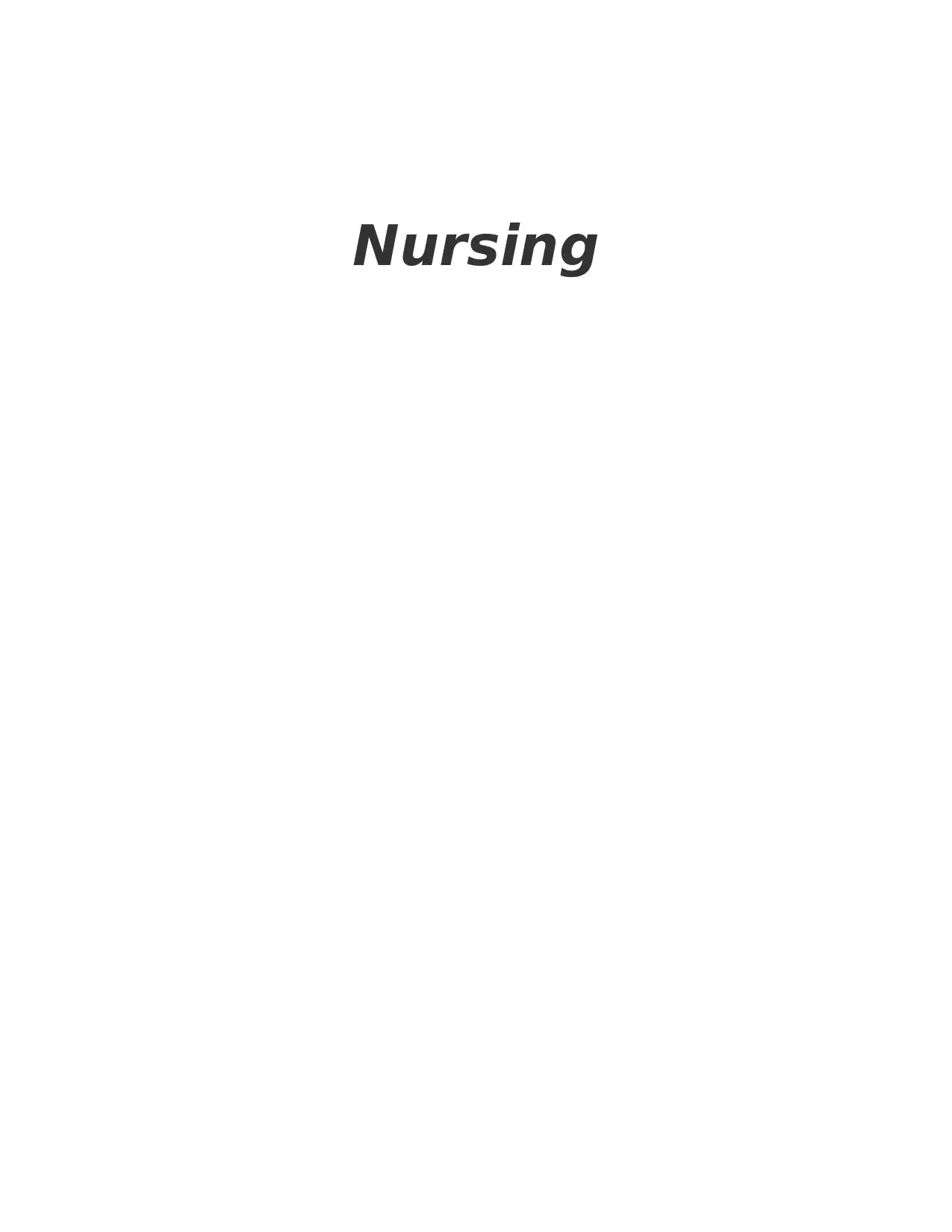
Nursing
Paraphrase This Document
Need a fresh take? Get an instant paraphrase of this document with our AI Paraphraser
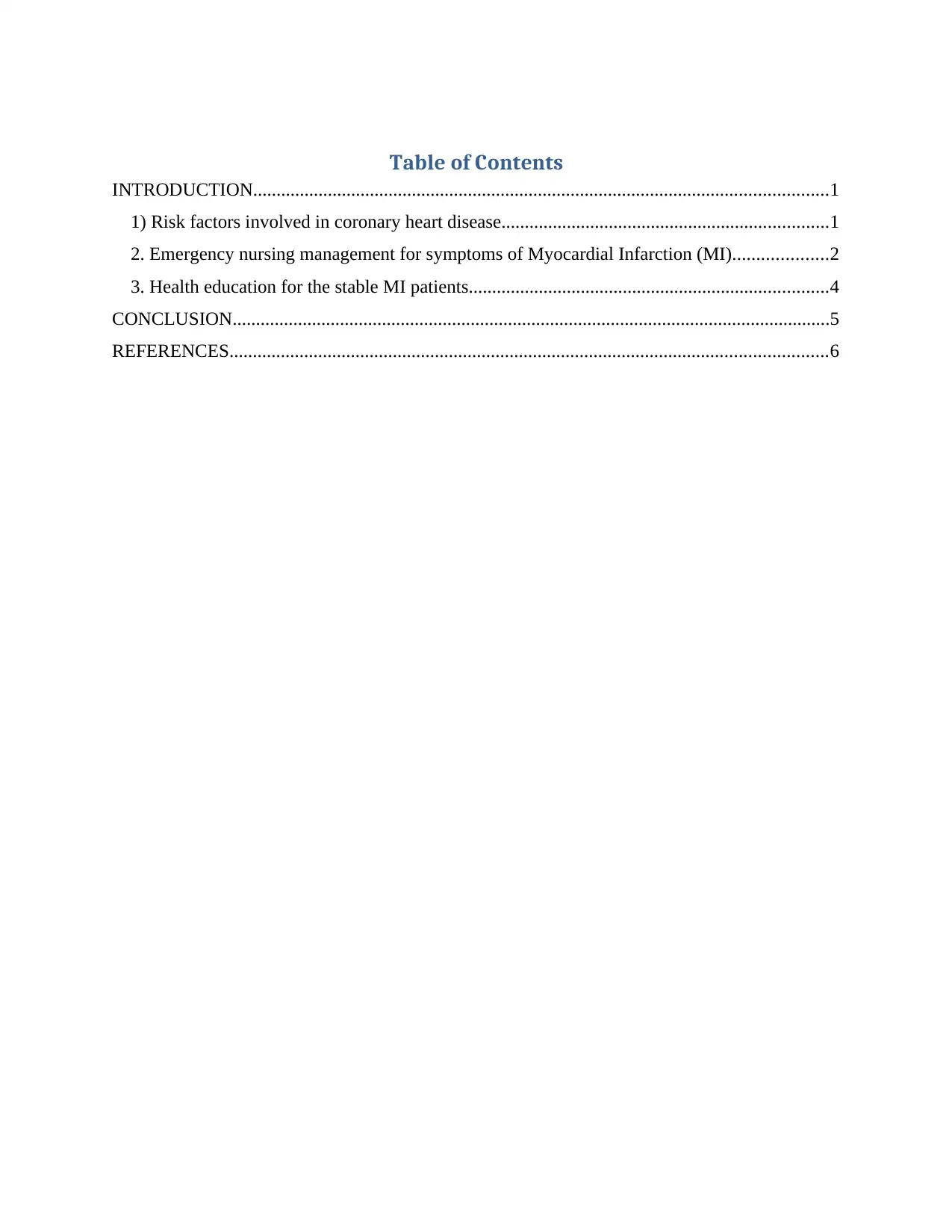
Table of Contents
INTRODUCTION...........................................................................................................................1
1) Risk factors involved in coronary heart disease......................................................................1
2. Emergency nursing management for symptoms of Myocardial Infarction (MI)....................2
3. Health education for the stable MI patients.............................................................................4
CONCLUSION................................................................................................................................5
REFERENCES................................................................................................................................6
INTRODUCTION...........................................................................................................................1
1) Risk factors involved in coronary heart disease......................................................................1
2. Emergency nursing management for symptoms of Myocardial Infarction (MI)....................2
3. Health education for the stable MI patients.............................................................................4
CONCLUSION................................................................................................................................5
REFERENCES................................................................................................................................6
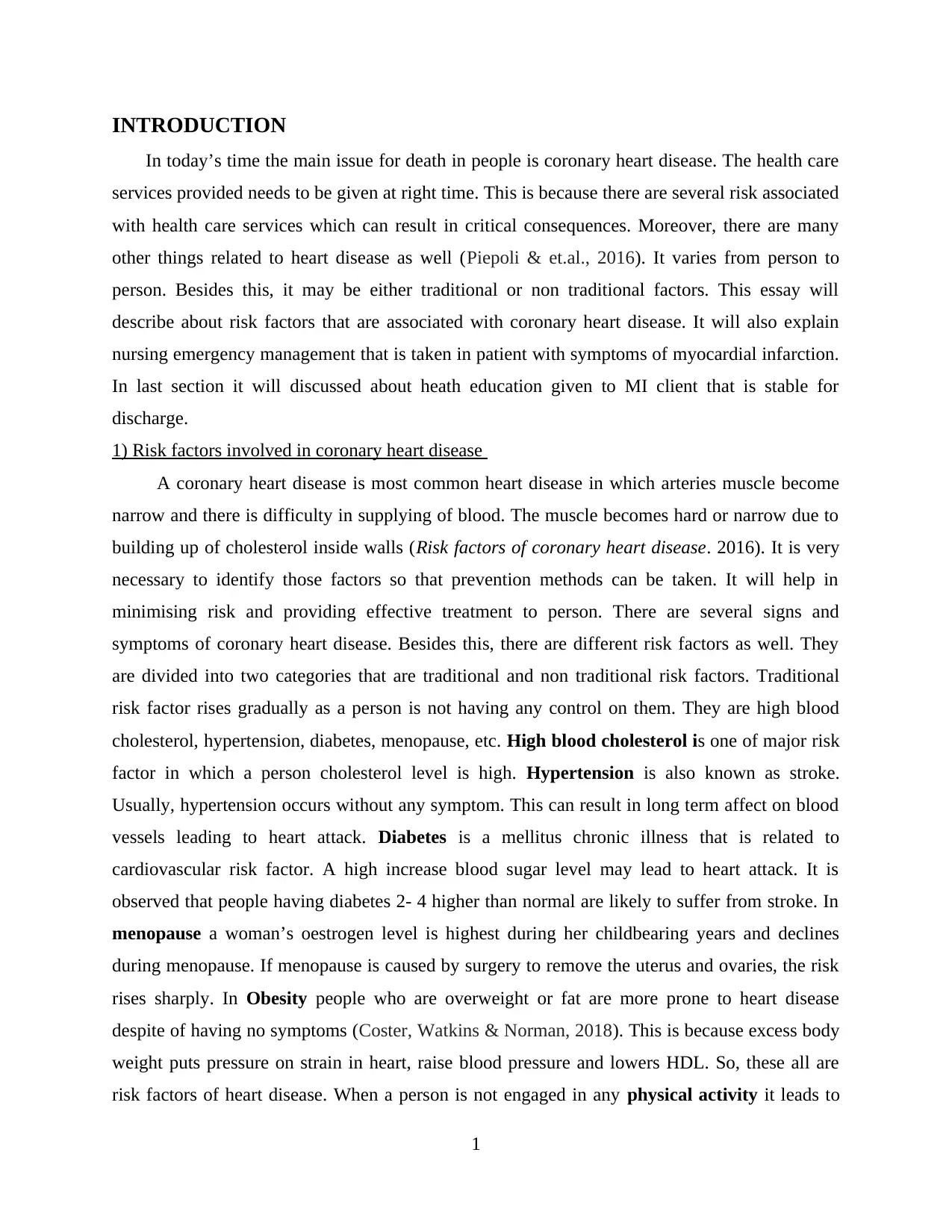
INTRODUCTION
In today’s time the main issue for death in people is coronary heart disease. The health care
services provided needs to be given at right time. This is because there are several risk associated
with health care services which can result in critical consequences. Moreover, there are many
other things related to heart disease as well (Piepoli & et.al., 2016). It varies from person to
person. Besides this, it may be either traditional or non traditional factors. This essay will
describe about risk factors that are associated with coronary heart disease. It will also explain
nursing emergency management that is taken in patient with symptoms of myocardial infarction.
In last section it will discussed about heath education given to MI client that is stable for
discharge.
1) Risk factors involved in coronary heart disease
A coronary heart disease is most common heart disease in which arteries muscle become
narrow and there is difficulty in supplying of blood. The muscle becomes hard or narrow due to
building up of cholesterol inside walls (Risk factors of coronary heart disease. 2016). It is very
necessary to identify those factors so that prevention methods can be taken. It will help in
minimising risk and providing effective treatment to person. There are several signs and
symptoms of coronary heart disease. Besides this, there are different risk factors as well. They
are divided into two categories that are traditional and non traditional risk factors. Traditional
risk factor rises gradually as a person is not having any control on them. They are high blood
cholesterol, hypertension, diabetes, menopause, etc. High blood cholesterol is one of major risk
factor in which a person cholesterol level is high. Hypertension is also known as stroke.
Usually, hypertension occurs without any symptom. This can result in long term affect on blood
vessels leading to heart attack. Diabetes is a mellitus chronic illness that is related to
cardiovascular risk factor. A high increase blood sugar level may lead to heart attack. It is
observed that people having diabetes 2- 4 higher than normal are likely to suffer from stroke. In
menopause a woman’s oestrogen level is highest during her childbearing years and declines
during menopause. If menopause is caused by surgery to remove the uterus and ovaries, the risk
rises sharply. In Obesity people who are overweight or fat are more prone to heart disease
despite of having no symptoms (Coster, Watkins & Norman, 2018). This is because excess body
weight puts pressure on strain in heart, raise blood pressure and lowers HDL. So, these all are
risk factors of heart disease. When a person is not engaged in any physical activity it leads to
1
In today’s time the main issue for death in people is coronary heart disease. The health care
services provided needs to be given at right time. This is because there are several risk associated
with health care services which can result in critical consequences. Moreover, there are many
other things related to heart disease as well (Piepoli & et.al., 2016). It varies from person to
person. Besides this, it may be either traditional or non traditional factors. This essay will
describe about risk factors that are associated with coronary heart disease. It will also explain
nursing emergency management that is taken in patient with symptoms of myocardial infarction.
In last section it will discussed about heath education given to MI client that is stable for
discharge.
1) Risk factors involved in coronary heart disease
A coronary heart disease is most common heart disease in which arteries muscle become
narrow and there is difficulty in supplying of blood. The muscle becomes hard or narrow due to
building up of cholesterol inside walls (Risk factors of coronary heart disease. 2016). It is very
necessary to identify those factors so that prevention methods can be taken. It will help in
minimising risk and providing effective treatment to person. There are several signs and
symptoms of coronary heart disease. Besides this, there are different risk factors as well. They
are divided into two categories that are traditional and non traditional risk factors. Traditional
risk factor rises gradually as a person is not having any control on them. They are high blood
cholesterol, hypertension, diabetes, menopause, etc. High blood cholesterol is one of major risk
factor in which a person cholesterol level is high. Hypertension is also known as stroke.
Usually, hypertension occurs without any symptom. This can result in long term affect on blood
vessels leading to heart attack. Diabetes is a mellitus chronic illness that is related to
cardiovascular risk factor. A high increase blood sugar level may lead to heart attack. It is
observed that people having diabetes 2- 4 higher than normal are likely to suffer from stroke. In
menopause a woman’s oestrogen level is highest during her childbearing years and declines
during menopause. If menopause is caused by surgery to remove the uterus and ovaries, the risk
rises sharply. In Obesity people who are overweight or fat are more prone to heart disease
despite of having no symptoms (Coster, Watkins & Norman, 2018). This is because excess body
weight puts pressure on strain in heart, raise blood pressure and lowers HDL. So, these all are
risk factors of heart disease. When a person is not engaged in any physical activity it leads to
1
⊘ This is a preview!⊘
Do you want full access?
Subscribe today to unlock all pages.

Trusted by 1+ million students worldwide
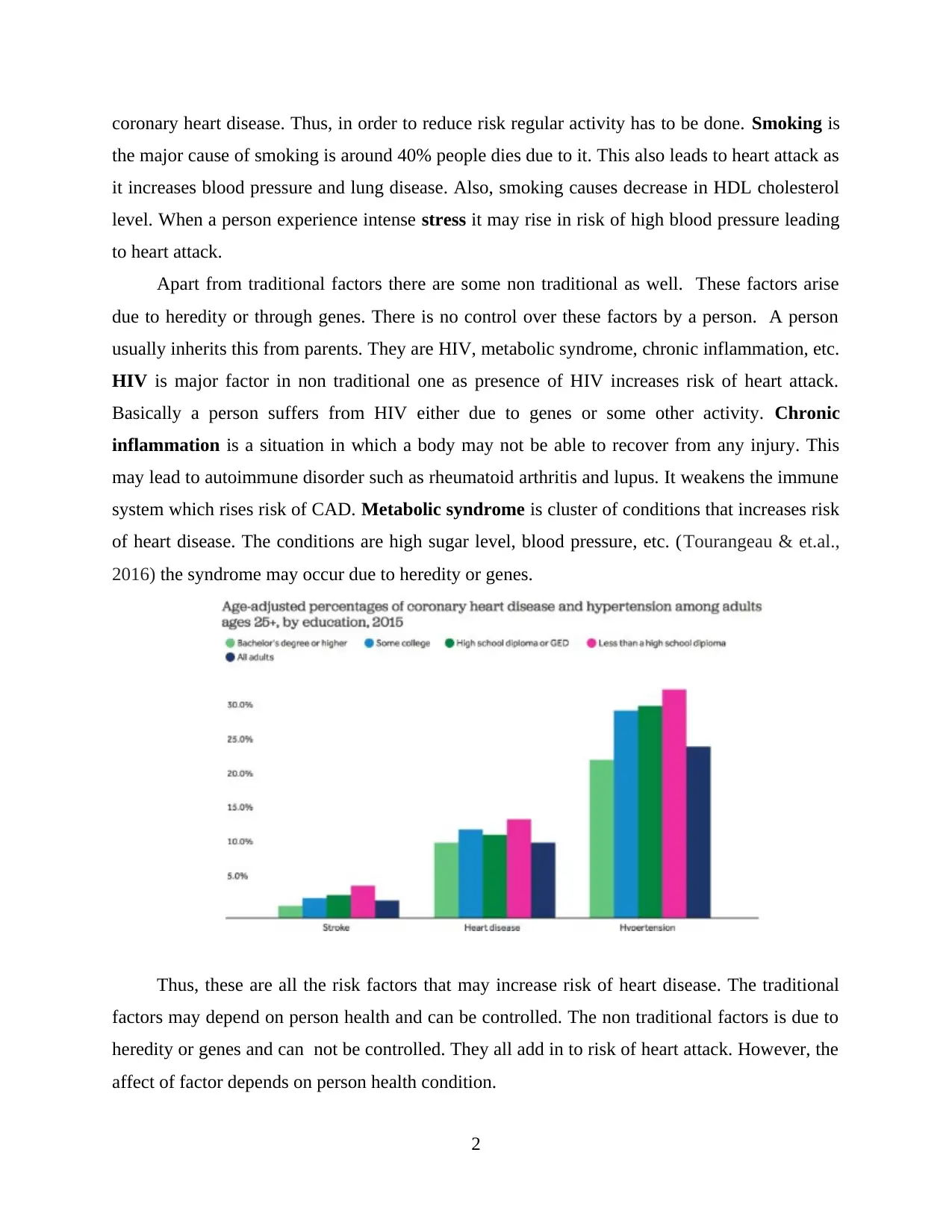
coronary heart disease. Thus, in order to reduce risk regular activity has to be done. Smoking is
the major cause of smoking is around 40% people dies due to it. This also leads to heart attack as
it increases blood pressure and lung disease. Also, smoking causes decrease in HDL cholesterol
level. When a person experience intense stress it may rise in risk of high blood pressure leading
to heart attack.
Apart from traditional factors there are some non traditional as well. These factors arise
due to heredity or through genes. There is no control over these factors by a person. A person
usually inherits this from parents. They are HIV, metabolic syndrome, chronic inflammation, etc.
HIV is major factor in non traditional one as presence of HIV increases risk of heart attack.
Basically a person suffers from HIV either due to genes or some other activity. Chronic
inflammation is a situation in which a body may not be able to recover from any injury. This
may lead to autoimmune disorder such as rheumatoid arthritis and lupus. It weakens the immune
system which rises risk of CAD. Metabolic syndrome is cluster of conditions that increases risk
of heart disease. The conditions are high sugar level, blood pressure, etc. (Tourangeau & et.al.,
2016) the syndrome may occur due to heredity or genes.
Thus, these are all the risk factors that may increase risk of heart disease. The traditional
factors may depend on person health and can be controlled. The non traditional factors is due to
heredity or genes and can not be controlled. They all add in to risk of heart attack. However, the
affect of factor depends on person health condition.
2
the major cause of smoking is around 40% people dies due to it. This also leads to heart attack as
it increases blood pressure and lung disease. Also, smoking causes decrease in HDL cholesterol
level. When a person experience intense stress it may rise in risk of high blood pressure leading
to heart attack.
Apart from traditional factors there are some non traditional as well. These factors arise
due to heredity or through genes. There is no control over these factors by a person. A person
usually inherits this from parents. They are HIV, metabolic syndrome, chronic inflammation, etc.
HIV is major factor in non traditional one as presence of HIV increases risk of heart attack.
Basically a person suffers from HIV either due to genes or some other activity. Chronic
inflammation is a situation in which a body may not be able to recover from any injury. This
may lead to autoimmune disorder such as rheumatoid arthritis and lupus. It weakens the immune
system which rises risk of CAD. Metabolic syndrome is cluster of conditions that increases risk
of heart disease. The conditions are high sugar level, blood pressure, etc. (Tourangeau & et.al.,
2016) the syndrome may occur due to heredity or genes.
Thus, these are all the risk factors that may increase risk of heart disease. The traditional
factors may depend on person health and can be controlled. The non traditional factors is due to
heredity or genes and can not be controlled. They all add in to risk of heart attack. However, the
affect of factor depends on person health condition.
2
Paraphrase This Document
Need a fresh take? Get an instant paraphrase of this document with our AI Paraphraser
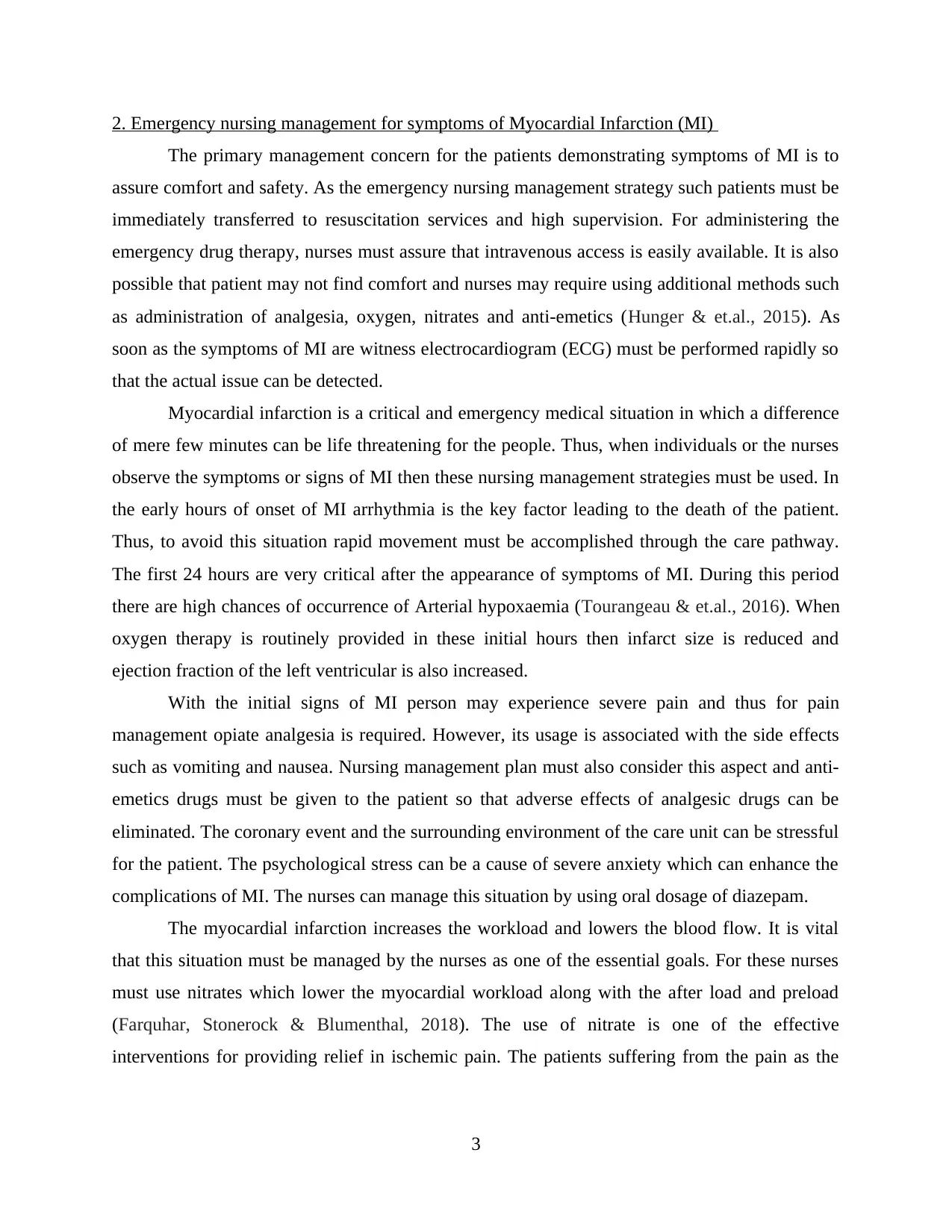
2. Emergency nursing management for symptoms of Myocardial Infarction (MI)
The primary management concern for the patients demonstrating symptoms of MI is to
assure comfort and safety. As the emergency nursing management strategy such patients must be
immediately transferred to resuscitation services and high supervision. For administering the
emergency drug therapy, nurses must assure that intravenous access is easily available. It is also
possible that patient may not find comfort and nurses may require using additional methods such
as administration of analgesia, oxygen, nitrates and anti-emetics (Hunger & et.al., 2015). As
soon as the symptoms of MI are witness electrocardiogram (ECG) must be performed rapidly so
that the actual issue can be detected.
Myocardial infarction is a critical and emergency medical situation in which a difference
of mere few minutes can be life threatening for the people. Thus, when individuals or the nurses
observe the symptoms or signs of MI then these nursing management strategies must be used. In
the early hours of onset of MI arrhythmia is the key factor leading to the death of the patient.
Thus, to avoid this situation rapid movement must be accomplished through the care pathway.
The first 24 hours are very critical after the appearance of symptoms of MI. During this period
there are high chances of occurrence of Arterial hypoxaemia (Tourangeau & et.al., 2016). When
oxygen therapy is routinely provided in these initial hours then infarct size is reduced and
ejection fraction of the left ventricular is also increased.
With the initial signs of MI person may experience severe pain and thus for pain
management opiate analgesia is required. However, its usage is associated with the side effects
such as vomiting and nausea. Nursing management plan must also consider this aspect and anti-
emetics drugs must be given to the patient so that adverse effects of analgesic drugs can be
eliminated. The coronary event and the surrounding environment of the care unit can be stressful
for the patient. The psychological stress can be a cause of severe anxiety which can enhance the
complications of MI. The nurses can manage this situation by using oral dosage of diazepam.
The myocardial infarction increases the workload and lowers the blood flow. It is vital
that this situation must be managed by the nurses as one of the essential goals. For these nurses
must use nitrates which lower the myocardial workload along with the after load and preload
(Farquhar, Stonerock & Blumenthal, 2018). The use of nitrate is one of the effective
interventions for providing relief in ischemic pain. The patients suffering from the pain as the
3
The primary management concern for the patients demonstrating symptoms of MI is to
assure comfort and safety. As the emergency nursing management strategy such patients must be
immediately transferred to resuscitation services and high supervision. For administering the
emergency drug therapy, nurses must assure that intravenous access is easily available. It is also
possible that patient may not find comfort and nurses may require using additional methods such
as administration of analgesia, oxygen, nitrates and anti-emetics (Hunger & et.al., 2015). As
soon as the symptoms of MI are witness electrocardiogram (ECG) must be performed rapidly so
that the actual issue can be detected.
Myocardial infarction is a critical and emergency medical situation in which a difference
of mere few minutes can be life threatening for the people. Thus, when individuals or the nurses
observe the symptoms or signs of MI then these nursing management strategies must be used. In
the early hours of onset of MI arrhythmia is the key factor leading to the death of the patient.
Thus, to avoid this situation rapid movement must be accomplished through the care pathway.
The first 24 hours are very critical after the appearance of symptoms of MI. During this period
there are high chances of occurrence of Arterial hypoxaemia (Tourangeau & et.al., 2016). When
oxygen therapy is routinely provided in these initial hours then infarct size is reduced and
ejection fraction of the left ventricular is also increased.
With the initial signs of MI person may experience severe pain and thus for pain
management opiate analgesia is required. However, its usage is associated with the side effects
such as vomiting and nausea. Nursing management plan must also consider this aspect and anti-
emetics drugs must be given to the patient so that adverse effects of analgesic drugs can be
eliminated. The coronary event and the surrounding environment of the care unit can be stressful
for the patient. The psychological stress can be a cause of severe anxiety which can enhance the
complications of MI. The nurses can manage this situation by using oral dosage of diazepam.
The myocardial infarction increases the workload and lowers the blood flow. It is vital
that this situation must be managed by the nurses as one of the essential goals. For these nurses
must use nitrates which lower the myocardial workload along with the after load and preload
(Farquhar, Stonerock & Blumenthal, 2018). The use of nitrate is one of the effective
interventions for providing relief in ischemic pain. The patients suffering from the pain as the
3
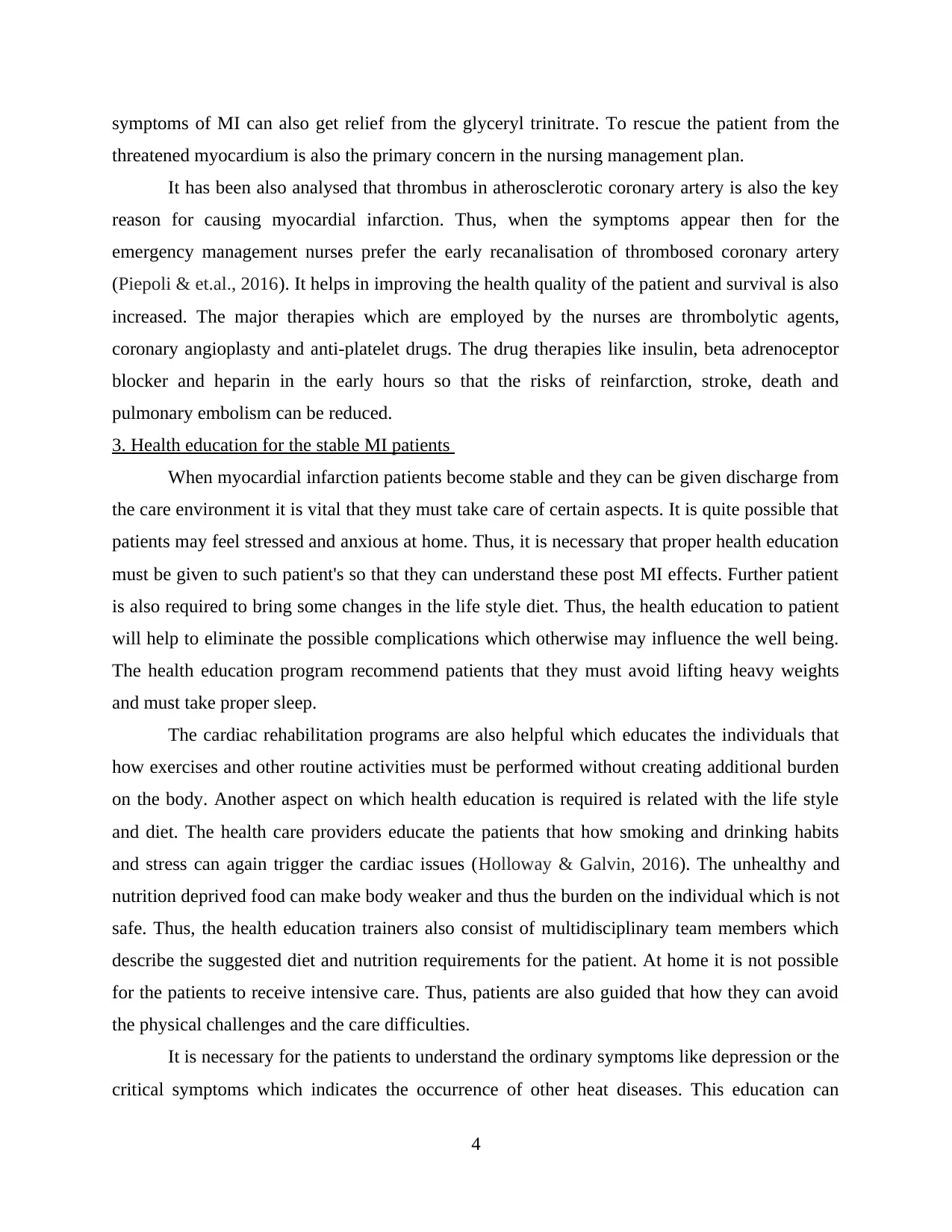
symptoms of MI can also get relief from the glyceryl trinitrate. To rescue the patient from the
threatened myocardium is also the primary concern in the nursing management plan.
It has been also analysed that thrombus in atherosclerotic coronary artery is also the key
reason for causing myocardial infarction. Thus, when the symptoms appear then for the
emergency management nurses prefer the early recanalisation of thrombosed coronary artery
(Piepoli & et.al., 2016). It helps in improving the health quality of the patient and survival is also
increased. The major therapies which are employed by the nurses are thrombolytic agents,
coronary angioplasty and anti-platelet drugs. The drug therapies like insulin, beta adrenoceptor
blocker and heparin in the early hours so that the risks of reinfarction, stroke, death and
pulmonary embolism can be reduced.
3. Health education for the stable MI patients
When myocardial infarction patients become stable and they can be given discharge from
the care environment it is vital that they must take care of certain aspects. It is quite possible that
patients may feel stressed and anxious at home. Thus, it is necessary that proper health education
must be given to such patient's so that they can understand these post MI effects. Further patient
is also required to bring some changes in the life style diet. Thus, the health education to patient
will help to eliminate the possible complications which otherwise may influence the well being.
The health education program recommend patients that they must avoid lifting heavy weights
and must take proper sleep.
The cardiac rehabilitation programs are also helpful which educates the individuals that
how exercises and other routine activities must be performed without creating additional burden
on the body. Another aspect on which health education is required is related with the life style
and diet. The health care providers educate the patients that how smoking and drinking habits
and stress can again trigger the cardiac issues (Holloway & Galvin, 2016). The unhealthy and
nutrition deprived food can make body weaker and thus the burden on the individual which is not
safe. Thus, the health education trainers also consist of multidisciplinary team members which
describe the suggested diet and nutrition requirements for the patient. At home it is not possible
for the patients to receive intensive care. Thus, patients are also guided that how they can avoid
the physical challenges and the care difficulties.
It is necessary for the patients to understand the ordinary symptoms like depression or the
critical symptoms which indicates the occurrence of other heat diseases. This education can
4
threatened myocardium is also the primary concern in the nursing management plan.
It has been also analysed that thrombus in atherosclerotic coronary artery is also the key
reason for causing myocardial infarction. Thus, when the symptoms appear then for the
emergency management nurses prefer the early recanalisation of thrombosed coronary artery
(Piepoli & et.al., 2016). It helps in improving the health quality of the patient and survival is also
increased. The major therapies which are employed by the nurses are thrombolytic agents,
coronary angioplasty and anti-platelet drugs. The drug therapies like insulin, beta adrenoceptor
blocker and heparin in the early hours so that the risks of reinfarction, stroke, death and
pulmonary embolism can be reduced.
3. Health education for the stable MI patients
When myocardial infarction patients become stable and they can be given discharge from
the care environment it is vital that they must take care of certain aspects. It is quite possible that
patients may feel stressed and anxious at home. Thus, it is necessary that proper health education
must be given to such patient's so that they can understand these post MI effects. Further patient
is also required to bring some changes in the life style diet. Thus, the health education to patient
will help to eliminate the possible complications which otherwise may influence the well being.
The health education program recommend patients that they must avoid lifting heavy weights
and must take proper sleep.
The cardiac rehabilitation programs are also helpful which educates the individuals that
how exercises and other routine activities must be performed without creating additional burden
on the body. Another aspect on which health education is required is related with the life style
and diet. The health care providers educate the patients that how smoking and drinking habits
and stress can again trigger the cardiac issues (Holloway & Galvin, 2016). The unhealthy and
nutrition deprived food can make body weaker and thus the burden on the individual which is not
safe. Thus, the health education trainers also consist of multidisciplinary team members which
describe the suggested diet and nutrition requirements for the patient. At home it is not possible
for the patients to receive intensive care. Thus, patients are also guided that how they can avoid
the physical challenges and the care difficulties.
It is necessary for the patients to understand the ordinary symptoms like depression or the
critical symptoms which indicates the occurrence of other heat diseases. This education can
4
⊘ This is a preview!⊘
Do you want full access?
Subscribe today to unlock all pages.

Trusted by 1+ million students worldwide
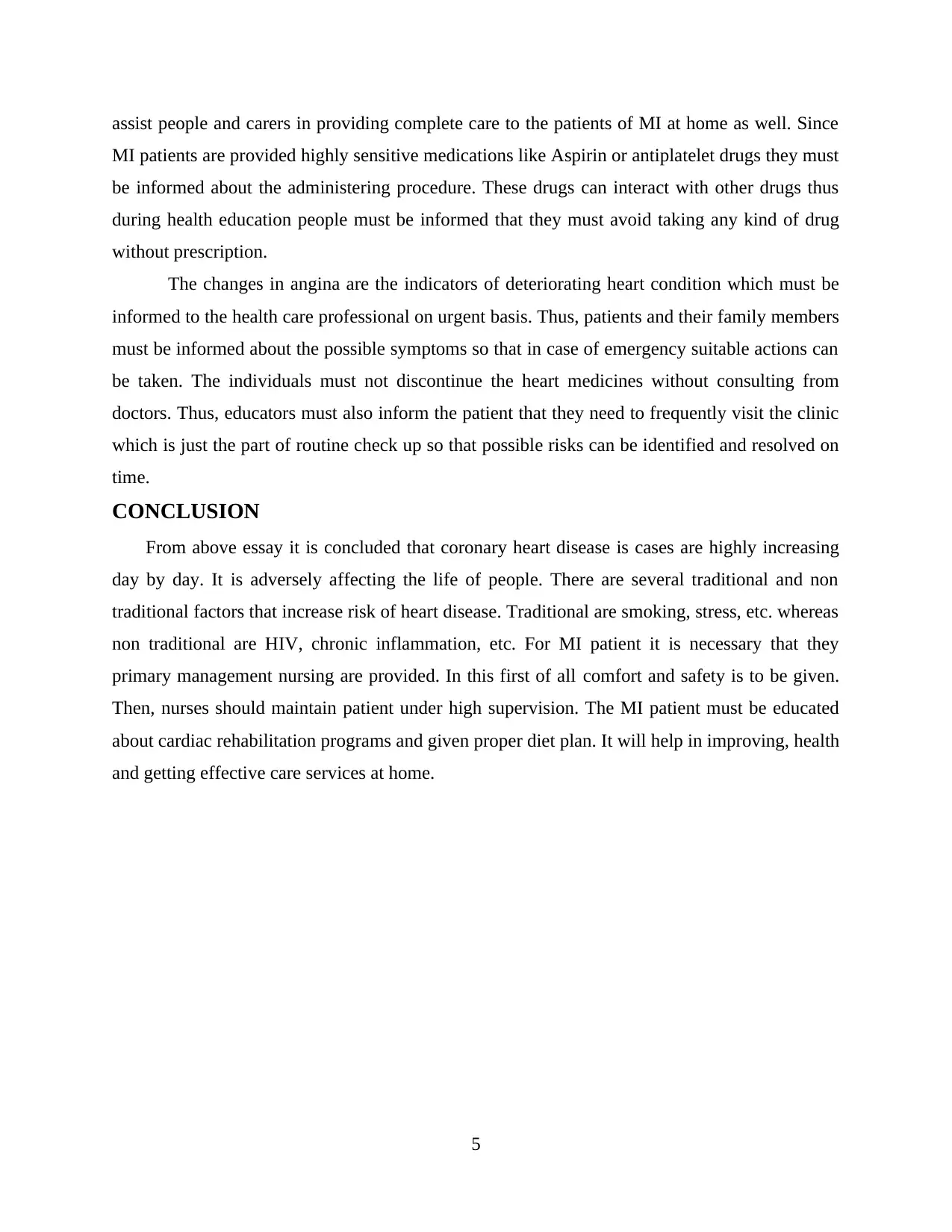
assist people and carers in providing complete care to the patients of MI at home as well. Since
MI patients are provided highly sensitive medications like Aspirin or antiplatelet drugs they must
be informed about the administering procedure. These drugs can interact with other drugs thus
during health education people must be informed that they must avoid taking any kind of drug
without prescription.
The changes in angina are the indicators of deteriorating heart condition which must be
informed to the health care professional on urgent basis. Thus, patients and their family members
must be informed about the possible symptoms so that in case of emergency suitable actions can
be taken. The individuals must not discontinue the heart medicines without consulting from
doctors. Thus, educators must also inform the patient that they need to frequently visit the clinic
which is just the part of routine check up so that possible risks can be identified and resolved on
time.
CONCLUSION
From above essay it is concluded that coronary heart disease is cases are highly increasing
day by day. It is adversely affecting the life of people. There are several traditional and non
traditional factors that increase risk of heart disease. Traditional are smoking, stress, etc. whereas
non traditional are HIV, chronic inflammation, etc. For MI patient it is necessary that they
primary management nursing are provided. In this first of all comfort and safety is to be given.
Then, nurses should maintain patient under high supervision. The MI patient must be educated
about cardiac rehabilitation programs and given proper diet plan. It will help in improving, health
and getting effective care services at home.
5
MI patients are provided highly sensitive medications like Aspirin or antiplatelet drugs they must
be informed about the administering procedure. These drugs can interact with other drugs thus
during health education people must be informed that they must avoid taking any kind of drug
without prescription.
The changes in angina are the indicators of deteriorating heart condition which must be
informed to the health care professional on urgent basis. Thus, patients and their family members
must be informed about the possible symptoms so that in case of emergency suitable actions can
be taken. The individuals must not discontinue the heart medicines without consulting from
doctors. Thus, educators must also inform the patient that they need to frequently visit the clinic
which is just the part of routine check up so that possible risks can be identified and resolved on
time.
CONCLUSION
From above essay it is concluded that coronary heart disease is cases are highly increasing
day by day. It is adversely affecting the life of people. There are several traditional and non
traditional factors that increase risk of heart disease. Traditional are smoking, stress, etc. whereas
non traditional are HIV, chronic inflammation, etc. For MI patient it is necessary that they
primary management nursing are provided. In this first of all comfort and safety is to be given.
Then, nurses should maintain patient under high supervision. The MI patient must be educated
about cardiac rehabilitation programs and given proper diet plan. It will help in improving, health
and getting effective care services at home.
5
Paraphrase This Document
Need a fresh take? Get an instant paraphrase of this document with our AI Paraphraser
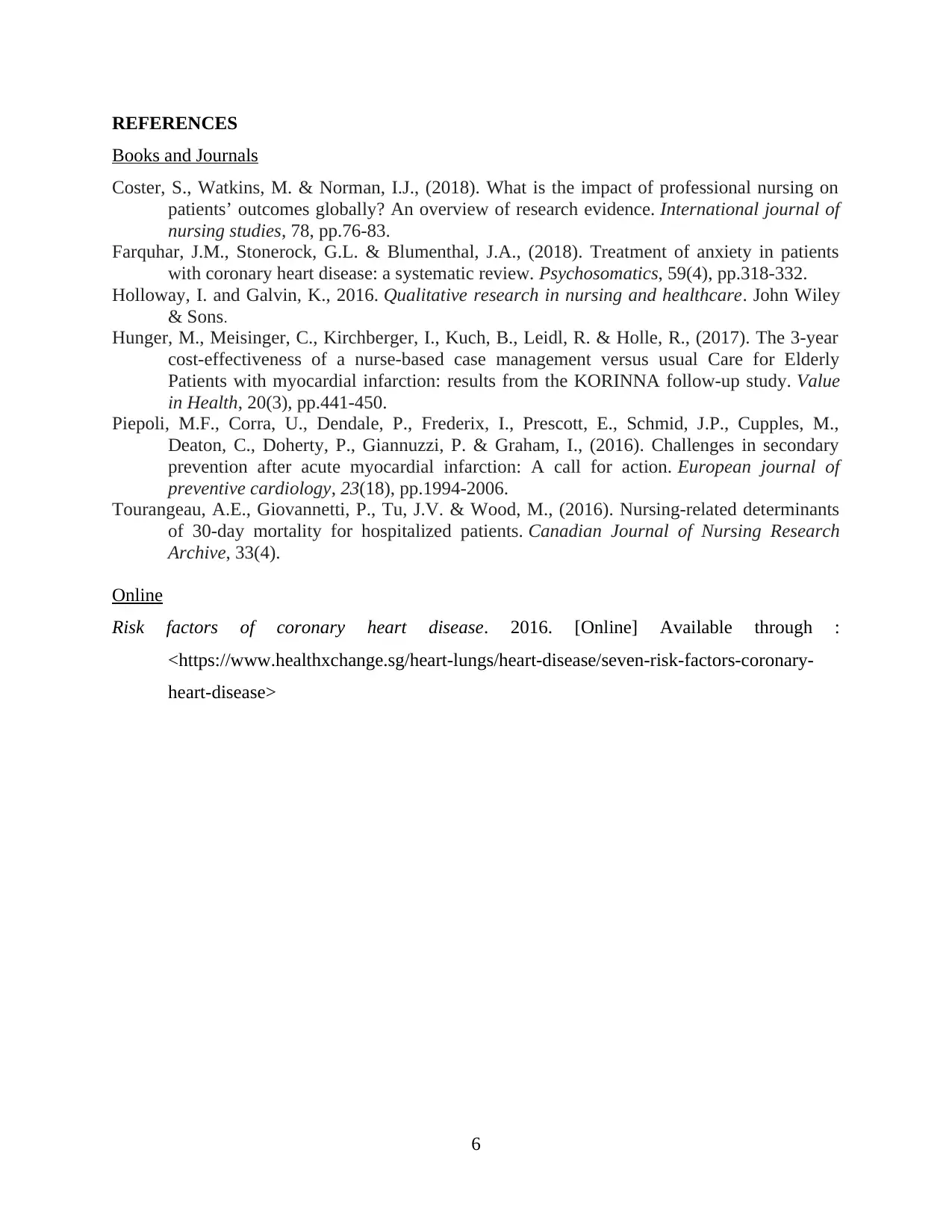
REFERENCES
Books and Journals
Coster, S., Watkins, M. & Norman, I.J., (2018). What is the impact of professional nursing on
patients’ outcomes globally? An overview of research evidence. International journal of
nursing studies, 78, pp.76-83.
Farquhar, J.M., Stonerock, G.L. & Blumenthal, J.A., (2018). Treatment of anxiety in patients
with coronary heart disease: a systematic review. Psychosomatics, 59(4), pp.318-332.
Holloway, I. and Galvin, K., 2016. Qualitative research in nursing and healthcare. John Wiley
& Sons.
Hunger, M., Meisinger, C., Kirchberger, I., Kuch, B., Leidl, R. & Holle, R., (2017). The 3-year
cost-effectiveness of a nurse-based case management versus usual Care for Elderly
Patients with myocardial infarction: results from the KORINNA follow-up study. Value
in Health, 20(3), pp.441-450.
Piepoli, M.F., Corra, U., Dendale, P., Frederix, I., Prescott, E., Schmid, J.P., Cupples, M.,
Deaton, C., Doherty, P., Giannuzzi, P. & Graham, I., (2016). Challenges in secondary
prevention after acute myocardial infarction: A call for action. European journal of
preventive cardiology, 23(18), pp.1994-2006.
Tourangeau, A.E., Giovannetti, P., Tu, J.V. & Wood, M., (2016). Nursing-related determinants
of 30-day mortality for hospitalized patients. Canadian Journal of Nursing Research
Archive, 33(4).
Online
Risk factors of coronary heart disease. 2016. [Online] Available through :
<https://www.healthxchange.sg/heart-lungs/heart-disease/seven-risk-factors-coronary-
heart-disease>
6
Books and Journals
Coster, S., Watkins, M. & Norman, I.J., (2018). What is the impact of professional nursing on
patients’ outcomes globally? An overview of research evidence. International journal of
nursing studies, 78, pp.76-83.
Farquhar, J.M., Stonerock, G.L. & Blumenthal, J.A., (2018). Treatment of anxiety in patients
with coronary heart disease: a systematic review. Psychosomatics, 59(4), pp.318-332.
Holloway, I. and Galvin, K., 2016. Qualitative research in nursing and healthcare. John Wiley
& Sons.
Hunger, M., Meisinger, C., Kirchberger, I., Kuch, B., Leidl, R. & Holle, R., (2017). The 3-year
cost-effectiveness of a nurse-based case management versus usual Care for Elderly
Patients with myocardial infarction: results from the KORINNA follow-up study. Value
in Health, 20(3), pp.441-450.
Piepoli, M.F., Corra, U., Dendale, P., Frederix, I., Prescott, E., Schmid, J.P., Cupples, M.,
Deaton, C., Doherty, P., Giannuzzi, P. & Graham, I., (2016). Challenges in secondary
prevention after acute myocardial infarction: A call for action. European journal of
preventive cardiology, 23(18), pp.1994-2006.
Tourangeau, A.E., Giovannetti, P., Tu, J.V. & Wood, M., (2016). Nursing-related determinants
of 30-day mortality for hospitalized patients. Canadian Journal of Nursing Research
Archive, 33(4).
Online
Risk factors of coronary heart disease. 2016. [Online] Available through :
<https://www.healthxchange.sg/heart-lungs/heart-disease/seven-risk-factors-coronary-
heart-disease>
6
1 out of 8
Related Documents
Your All-in-One AI-Powered Toolkit for Academic Success.
+13062052269
info@desklib.com
Available 24*7 on WhatsApp / Email
![[object Object]](/_next/static/media/star-bottom.7253800d.svg)
Unlock your academic potential
Copyright © 2020–2025 A2Z Services. All Rights Reserved. Developed and managed by ZUCOL.





